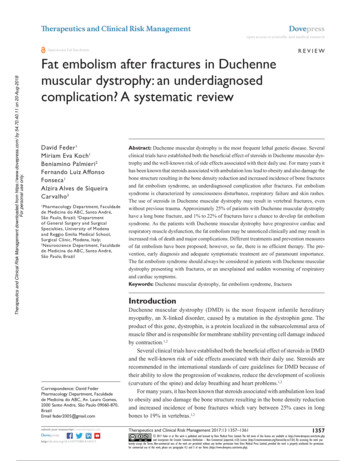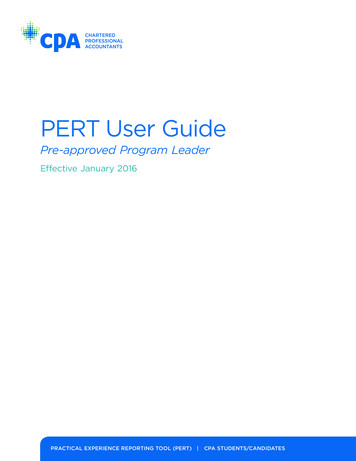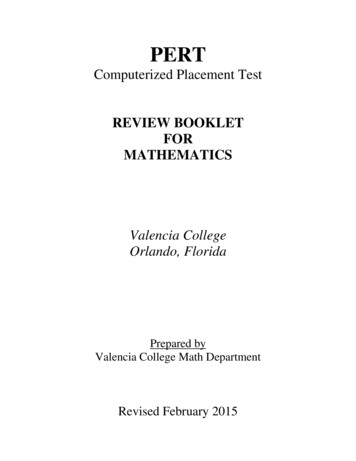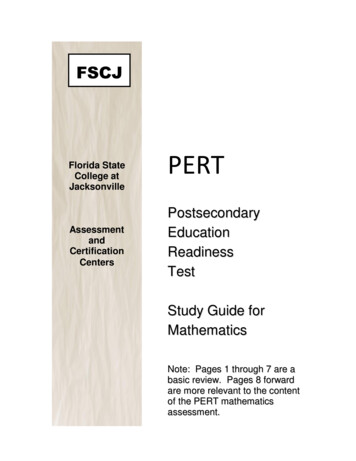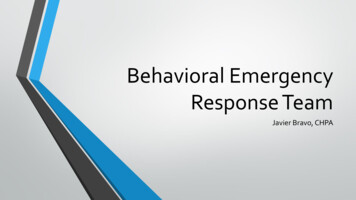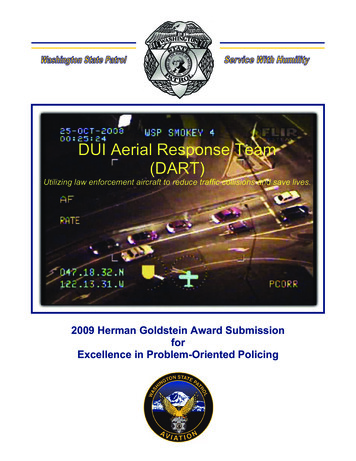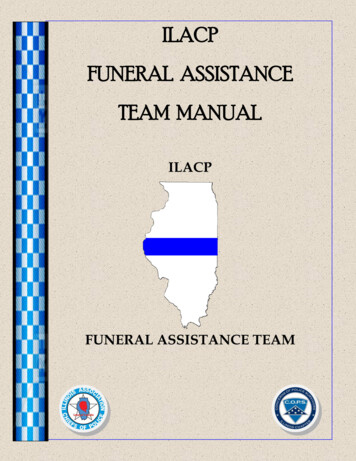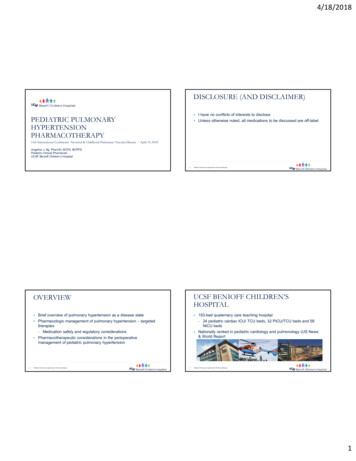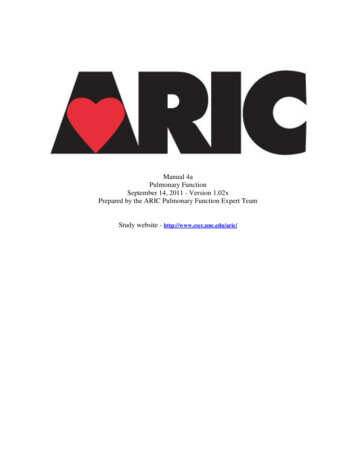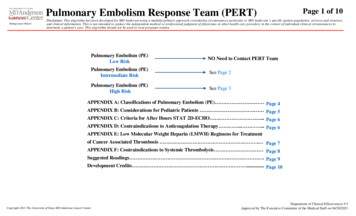
Transcription
Pulmonary Embolism Response Team (PERT)Page 1 of 10Disclaimer: This algorithm has been developed for MD Anderson using a multidisciplinary approach considering circumstances particular to MD Anderson’s specific patient population, services and structure,and clinical information. This is not intended to replace the independent medical or professional judgment of physicians or other health care providers in the context of individual clinical circumstances todetermine a patient's care. This algorithm should not be used to treat pregnant women.Pulmonary Embolism (PE)Low RiskNO Need to Contact PERT TeamPulmonary Embolism (PE)Intermediate RiskSee Page 2Pulmonary Embolism (PE)High RiskSee Page 3APPENDIX A: Classifications of Pulmonary Embolism (PE) Page 4APPENDIX B: Considerations for Pediatric Patients Page 5APPENDIX C: Criteria for After Hours STAT 2D-ECHO . . Page 6APPENDIX D: Contraindications to Anticoagulation Therapy . . Page 6APPENDIX E: Low Molecular Weight Heparin (LMWH) Regimens for Treatmentof Cancer Associated Thrombosis Page 7APPENDIX F: Contraindications to Systemic Thrombolysis Page 8Suggested Readings . Page 9Development Credits . . Page 10Department of Clinical Effectiveness V3Approved by The Executive Committee of the Medical Staff on 04/20/2021
Page 2 of 10Pulmonary Embolism Response Team (PERT)Disclaimer: This algorithm has been developed for MD Anderson using a multidisciplinary approach considering circumstances particular to MD Anderson’s specific patient population, services and structure,and clinical information. This is not intended to replace the independent medical or professional judgment of physicians or other health care providers in the context of individual clinical circumstances todetermine a patient's care. This algorithm should not be used to treat pregnant women.INITIAL EVALUATION – INTERMEDIATE RISKPERT First Responder1 contacted for patient withPulmonary Embolism (PE) and Intermediate Risk2 Notify Primary Team (if not already aware of PE) For Pediatric considerations, see Appendix BObtain the following (if notalready done): NT-proBNP, troponin T, typeand screen3 Routine 2D-ECHO EKG 12-Lead (portable) Ultrasound of leg or venousdoppler bilaterally as clinicallyindicatedAbsolutecontraindication4to ed byPESI score5High-Intermediate2Risk PE andPESI score 86orLow-Intermediate2Risk PE Transferthe patient tocardiac monitoring bed ObserveHigh-Intermediate2Risk PE andPESI score 86Yes Transferthepatient to ICU ObserveTemporarycontraindication toanticoagulant?NoRetrievableIVC filter6PermanentIVC filterPERT virtual meeting considerations: Life expectancy and Performance Status Mechanical thrombectomy Low dose catheter directed thrombolysis IVC filterFollow-upas clinicallyindicatedNoStart IV unfractionatedheparin7,8,9RR 30 breaths/minute orO2 saturation on room air 90% orHR 110 beats/minute orSBP 100 mmHg orAMSYesYesNoRR respiratory rateHR heart rateSBP systolic blood pressureAMS altered mental status1PERT First Responder: On-Call fellow/trainee and attending provider2See Appendix A: Classifications of Pulmonary Embolism3See Appendix C: Criteria for After Hours STAT 2D-ECHO4See Appendix D: Contraindications to Anticoagulation Therapy5PESI score ism-severity-index-pesi -index-pesi-score-calculator-1186Risk stratificationassessed by PESIscore5Start LMWH 9,10 twice daily11High-Intermediate2Risk PE andPESI score 86High-Intermediate2Risk PE andPESI score 86orLow-Intermediate2Risk PEContinue anticoagulation Transfer the patient to ICU Observe Continueanticoagulation Transfer the patient tocardiac monitoring bed ObserveCriteria to consider for placement of a retrievable filter: If temporary/limited time ( 2-3 months) of contraindication to anticoagulants Greater than 6 months survival expected Performance Status 17Refer to Adult Heparin Infusion order set8If patient has a history of heparin induced thrombocytopenia (HIT), see Heparin Induded Thrombocytopenia (HIT) Treatment algorithm for management9May consider Low Intensity dosing of IV unfractionated heparin for patients with relative contraindication to anticoagulation therapy (see Appendix D).If the risk is still too high, see Box A for Absolute contraindication to anticoagulation .10See Appendix E: Low Molecular Weight Heparin (LMWH) Regimens for Treatment of Cancer Associated Thrombosis11Department of Clinical Effectiveness V3Twice daily dose is applicable for enoxaparin only (not dalteparin)Approved by The Executive Committee of the Medical Staff on 04/20/2021
Page 3 of 10Pulmonary Embolism Response Team (PERT)Disclaimer: This algorithm has been developed for MD Anderson using a multidisciplinary approach considering circumstances particular to MD Anderson’s specific patient population, services and structure,and clinical information. This is not intended to replace the independent medical or professional judgment of physicians or other health care providers in the context of individual clinical circumstances todetermine a patient's care. This algorithm should not be used to treat pregnant women.INITIAL EVALUATION – HIGH RISKTREATMENTPERT First Responder1 contacted for patient withPulmonary Embolism (PE) and High Risk2 Notify Primary Team (if not already aware of PE) For Pediatric considerations, see Appendix B Obtainthe following (if not already done): NT-proBNP, troponin T, type and screen3 Routine 2D-ECHO EKG 12-Lead (portable) Ultrasound of leg or venous Dopplerbilaterally as clinically indicated Transfer the patient to ICUContraindication4to anticoagulation?PERT virtual meeting considerations: Life expectancy and Performance Status Mechanical thrombectomy Low dose catheter directed thrombolysis IVC filter placement Transfer to a cardiac center for surgicalthrombectomyYesYesNoStart IV unfractionated heparin 5,61Contraindicationto systemicthrombolytics7?NoTreat withPERT First Responder: On-call fellow/trainee and attending providersSystolic BPsystemicNoSee Appendix A: Classifications of Pulmonary Embolism 90 mmHg?3thrombolytics8See Appendix C: Criteria for After Hours STAT 2D-ECHO4See Appendix D: Contraindications to Anticoagulation Therapy5Refer to Adult Heparin Infusion order set6If patient has a history of HIT, see Heparin Induced Thrombocytopenia Treatment (HIT) algorithm for management7See Appendix F: Contraindications to Systemic Thrombolysis8 If patient is on heparin infusion, hold heparin infusion and administer alteplase 100 mg IV infusion over 2 hours. Check aPTT immediately after alteplase infusion is complete andrestart heparin infusion without bolus if aPTT is 80 seconds. If aPTT is 80 seconds, continue to hold heparin infusion and check aPTT every 2 hours until aPTT is 80 seconds. If patient is on LMWH prior to alteplase, discontinue LMWH and start heparin infusion without a bolus at the time of the next scheduled dose of LMWH If patient is on a direct-acting oral anticoagulants (DOAC) prior to alteplase, discontinue DOAC and start heparin infusion without a bolus at the time of the next scheduled dose of DOAC2YesFollow-up asclinicallyindicatedDepartment of Clinical Effectiveness V3Approved by The Executive Committee of the Medical Staff on 04/20/2021
Pulmonary Embolism Response Team (PERT)Page 4 of 10Disclaimer: This algorithm has been developed for MD Anderson using a multidisciplinary approach considering circumstances particular to MD Anderson’s specific patient population, services and structure,and clinical information. This is not intended to replace the independent medical or professional judgment of physicians or other health care providers in the context of individual clinical circumstances todetermine a patient's care. This algorithm should not be used to treat pregnant women.APPENDIX A: Classifications of Pulmonary Embolism (PE)Risk LevelsClassificationsNo hypotension and No RV dysfunction and No myocardial necrosis or strain Low RiskLow-IntermediateRiskHigh-IntermediateRiskRV dysfunction by CT or ECHO or Myocardial necrosis or strain (elevated Troponin T or NT-proBNP) RV dysfunction by CT or ECHO andMyocardial necrosis or strain (elevated Troponin T or NT-proBNP) and/or Absence of signs of hypotension or shock Sustained hypotension (SBP less than 90 mmHg) at least 15 minutes or Persistent bradycardia (HR less than 40 bpm) or signs and symptoms of shock or Need for inotropic support High RiskDepartment of Clinical Effectiveness V3Approved by The Executive Committee of the Medical Staff on 04/20/2021
Pulmonary Embolism Response Team (PERT)Page 5 of 10Disclaimer: This algorithm has been developed for MD Anderson using a multidisciplinary approach considering circumstances particular to MD Anderson’s specific patient population, services and structure,and clinical information. This is not intended to replace the independent medical or professional judgment of physicians or other health care providers in the context of individual clinical circumstances todetermine a patient's care. This algorithm should not be used to treat pregnant women.APPENDIX B: Considerations for Pediatric Patients ( 18 years old)PESI score was not validated in pediatric patients. To determine PE risk category, level of care, and management – consult general pediatrics. For unstable patients,contact the pediatric intensive care unit provider. If heparin is used in the management of pediatric patients, refer to the Pediatric Treatment of VTE with Unfractionated Heparin Infusion order set The preferred LMWH in pediatric patients is enoxaparin 1 mg/kg subcutaneous every 12 hours. Doses should be held for platelets 30 K/microliter Dosing of alteplase for pediatrics patients: 0.5 mg/kg/hour IV infusion over 6 hours Vital sign considerations for pediatric patients: AgeNormal awake Heart RateBeats/minuteNormal Respiratory RateBreaths/minuteDefinition of HypotensionNewborn (up to 1 months)100-20530-53SBP 60 (applies to 0 to 28 days)Infant (1 - 12 months)100-18030-53SBP 70 (applies to 1 - 12 months)Toddler (1 - 2 years)98-14022-37SBP 70 (age in years x 2) (applies to 1 - 10 years)Preschooler (3 - 5 years)80-12020-28SBP 70 (age in years x 2) (applies to 1 - 10 years)Child (6 - 11 years)75-11818-25SBP 70 (age in years x 2) (applies to 1 - 10 years)Adolescent (12 - 18 years)60-10012-20SBP 90 (applies to 10 years)Department of Clinical Effectiveness V3Approved by The Executive Committee of the Medical Staff on 04/20/2021
Pulmonary Embolism Response Team (PERT)Page 6 of 10Disclaimer: This algorithm has been developed for MD Anderson using a multidisciplinary approach considering circumstances particular to MD Anderson’s specific patient population, services and structure,and clinical information. This is not intended to replace the independent medical or professional judgment of physicians or other health care providers in the context of individual clinical circumstances todetermine a patient's care. This algorithm should not be used to treat pregnant women.APPENDIX C: Criteria for After Hours STAT 2D-ECHOCriteria Patient hasto be seen first by a member of the PERT team in order to confirm that none of the other imaging modalities are possible (CT angiogram or ventilation-perfusion (VQ) scan) Patient is hemodynamically unstable (Systolic Blood Pressure (SBP) 90 mmHg or receiving vasopressors) PE has to be highly suspected and no other etiology would explain shock (no septic, hemorrhagic or hypovolemic shock) PERT team member is to contact and discuss directly the need of the echo with the cardiologist on-call before sonographer is contacted.APPENDIX D: Contraindications to Anticoagulation TherapyAbsolute ContraindicationsRelative Contraindicationsactive bleeding (e.g. bleeding requiring 2 units of packed red bloodcells (PRBC) transfusion, decrease in hemoglobin 2 g/dL, or bleeding in acritical area or organ) Platelet 25 K/microliter, consult to benign hematology Spinal procedure and/or epidural placement Severe uncontrolled malignant hypertension Brain Majormetastases conferring risk of bleeding (renal, choriocarcinoma, melanoma, thyroid cancer)or central nervous system (CNS) bleeding within the past 4 weeks Recent high-risk surgery or bleeding event Active but non-life threatening bleeding Active GI ulceration at high risk of bleeding Platelets 50 K/microliter, consider consult to benign hematology Patient currently on active protocol that prohibits use of anticoagulation IntracranialDepartment of Clinical Effectiveness V3Approved by The Executive Committee of the Medical Staff on 04/20/2021
Pulmonary Embolism Response Team (PERT)Page 7 of 10Disclaimer: This algorithm has been developed for MD Anderson using a multidisciplinary approach considering circumstances particular to MD Anderson’s specific patient population, services and structure,and clinical information. This is not intended to replace the independent medical or professional judgment of physicians or other health care providers in the context of individual clinical circumstances todetermine a patient's care. This algorithm should not be used to treat pregnant women.APPENDIX E: Low Molecular Weight Heparin (LMWH)1 Regimens for Treatment of Cancer Associated ThrombosisDalteparin (Fragmin )**FDA approvedfor cancer patientsRound to nearest International Units (IU)dose, given subcutaneously dailyActual BodyMonth 1Months 2-6200IU/kg150 IU/kgWeight (kg) 5657-6869-8283-98Hold in patients withplatelets 25 K/microliter MONITORING 2DOSE / ROUTE / FREQUENCYDRUG 9910,000 IU12,500 IU15,000 IU18,000 IU7,500 IU10,000 IU12,500 IU15,000 IU BaselineCBC withdifferential, aPTT,PT and serumcreatinine For surgical patients,platelets every 3daysbetween days 4and 14 afterbeginning LMWHthen, as clinicallyindicatedDOSE ADJUSTMENTSPlatelets: Consider reducing the daily dose by 2,500 units when platelets are between50-100 K/microliter and use with caution in cancer patients when platelets are 50 K/ microliter For platelet count 25 K/microliter, hold dalteparinRenal: If creatinine clearance 30 mL/minute: adjust dose to obtain anti-Xa level of0.5-1.5 IU/mL (4-6 hours after fourth dose)Weight: Obtain anti-Xa level in patients weighing 150 kg or 50 kg, or BMI 40 kg/m2and adjust dose to obtain anti-Xa level of 0.5-1.5 IU/mL (4-6 hours after fourthdose)Consider monitoring anti-Xa levels and adjust dose as needed. Limited data suggests dalteparin 200 IU/kg based on actual body weight(with no dose capping) in one or two divided doses3. An alternative option is enoxaparin 1 mg/kg twice daily (see below).Enoxaparin (Lovenox )1 mg/kg subcutaneously every 12 hours 1Hold in patients withplatelets 25 K/microliterSame as abovePlatelets: Limited data suggest the following enoxaparin dose modification:platelet count 50 K/microliter: full-dose, 1 mg/kg twice daily For platelet count 25-50 K/microliter: half-dose, 0.5 mg/kg twice daily For platelet count 25 K/microliter, hold all anticoagulants ForLimited data suggest once per daydosing is inferior in cancer patientsand may increase risk of bleeding Limited data suggest dose of0.75-0.85 mg/kg every 12 hours inobese patients (BMI 40 kg/m2) Renal: If creatinine clearance 30 mL/minute: 1mg/kg dailyWeight: Obtain anti-Xa level in patients weighing 150 kg or 50 kg, or BMI 40 kg/m2 For 1 mg/kg every 12 hour dosing regimen: adjust dose to obtain anti-Xa level of0.6-1 IU/mL (4-6 hours after fourth dose)Notes: LMWH are preferred agents Patients who tolerate anticoagulation should be continued on it indefinitely or until active cancer resolves Patient should be observed closely for bleeding and signs and symptoms of neurological impairment if therapy is administered during or immediately following diagnostic lumbar puncture, epidural anesthesia, or spinal anesthesia23If lab results indicate heparin induced thrombocytopenia, follow management guideline per Heparin Induced Thrombocytopenia (HIT) Treatment algorithmMulti-dose vials not recommended for home useDepartment of Clinical Effectiveness V3Approved by The Executive Committee of the Medical Staff on 04/20/2021
Page 8 of 10Pulmonary Embolism Response Team (PERT)Disclaimer: This algorithm has been developed for MD Anderson using a multidisciplinary approach considering circumstances particular to MD Anderson’s specific patient population, services and structure,and clinical information. This is not intended to replace the independent medical or professional judgment of physicians or other health care providers in the context of individual clinical circumstances todetermine a patient's care. This algorithm should not be used to treat pregnant women.APPENDIX F: Contraindications to Systemic Thrombolysis1Absolute Contraindications:Relative Contraindications: Active bleeding History of hemorrhagic stroke or stroke of unknown origin Intracranial tumor Ischemic stroke within the past 3 months1 Recent brain or spinal surgery and/or head or facial trauma Suspected or confirmed aortic dissection Platelet count below 100 K/microliter Age 75 years old Pregnancy or first post-partum week Non-compressible puncture sites Traumatic cardiopulmonary resuscitation Recent major surgery, invasive procedure, and/or trauma (within 1 Refractory hypertension (SBP 180 mmHg, DBP 110 mmHg) Known bleeding diathesis or acquired coagulopathy Significant non-intracranial bleeding within 1 month Life expectancy less than or equal to 6 monthsmonth)Discussion with neurosurgery for recent brain or spinal surgeryDepartment of Clinical Effectiveness V3Approved by The Executive Committee of the Medical Staff on 04/20/2021
Pulmonary Embolism Response Team (PERT)Page 9 of 10Disclaimer: This algorithm has been developed for MD Anderson using a multidisciplinary approach considering circumstances particular to MD Anderson’s specific patient population, services and structure,and clinical information. This is not intended to replace the independent medical or professional judgment of physicians or other health care providers in the context of individual clinical circumstances todetermine a patient's care. This algorithm should not be used to treat pregnant women.SUGGESTED READINGSAujesky, D., Obrosky, D. S., Stone, R. A., Auble, T. E., Perrier, A., Cornuz, J., Fine, M. J. (2005). Derivation and validation of a prognostic model for pulmonary embolism.American Journal of Respiratory and Critical Care Medicine, 172(8), 1041-1046. doi: 10.1164/rccm.200506-862OCChan, C. M., Woods, C., & Shorr, A. F. (2010). The validation and reproducibility of the pulmonary embolism severity index. Journal of Thrombosis and Haemostasis, 8(7), 1509–1514. doi:10.1111/j.1538-7836.2010.03888.xDouketis, J. D., Spyropoulos, A. C., Spencer, F. A., Mayr, M., Jaffer, A. K., Eckman, M. H., Kunz, R. (2012). Perioperative management of antithrombotic therapy.Antithrombotic therapy and prevention of thrombosis, 9th ed: American College of Chest Physicians evidence-based clinical practice guidelines. Chest, 141(2 suppl),e326S-e350S. doi:10.1378/chest.11-2298Kabrhel, C., Jaff, M. R., Channick, R. N., Baker, J. N., & Rosenfield, K. (2013). A multidisciplinary pulmonary embolism response team. Chest, 144(5), 1738-1739.doi:10.1378/chest.13-1562Konstantinides, S. V., Torbicki, A., Agnelli, G., Danchin, N., Fitzmaurice, D., Galiè, N., Spyropoulos, A. C. (2014). 2014 ESC guidelines on the diagnosis and management ofacute pulmonary embolism: The task force for the diagnosis and management of acute pulmonary embolism of the European Society of Cardiology (ESC). European HeartJournal, 35(43), 3033-3080. doi:1093/eurheartj/
IVC filter6 Permanent IVC filter RR respiratory rate HR heart rate SBP systolic blood pressure AMS altered mental status 1 PERT First Responder: On-Call fellow/trainee and attending provider 2 See Appendix A: Classifications of Pulmonary Embolism 3 See Appendix C:
